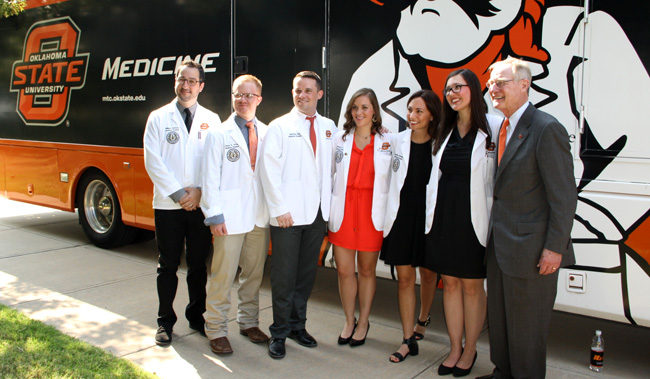TSET Board of Directors awards grant to support OSU-CHS Medical Residency Programs
Wednesday, August 26, 2015
TSET, the Tobacco Settlement Endowment Trust, is partnering with Oklahoma State University Center for Health Sciences and OSU Medical Authority to support the launch of medical residency programs to place doctors in rural and medically underserved portions of the state with a new grant that began this summer.
The TSET Board of Directors has awarded a six-year, $3.8 million grant to Oklahoma State University Medical Authority to address the critical shortage of physicians in Oklahoma.
“This grant will help ensure that Oklahomans in rural areas have better access to the doctors they need,” said Governor Mary Fallin. “This is an excellent example of state agencies and the higher education community working hand-in-hand to support the goal of improving health outcomes across Oklahoma.”
“Partnering to bring additional doctors to rural areas complements our efforts to create a healthier Oklahoma in all pockets of the state,” said TSET Board of Director Chairman Jim Gebhart. “We know helping people – especially children and families – to develop healthy habits is our first line of defense in changing Oklahoma’s health outcomes. Partnering with Oklahoma State University to recruit more residents to areas where health care is scarce is another facet of helping to achieve this goal.”
This grant will consist of bridge funding for the training of physicians in Oklahoma. At the end of the six-year grant, federal health care dollars will be used to support the program that seeks to add more doctors to Oklahoma’s health care system, especially in rural areas.
“TSET funding will ignite a cascade of positive changes for these targeted communities, starting with a sustained influx of new primary care physicians, better health outcomes and improved economic factors,” said OSU President Burns Hargis. “All of the dollars from the grant go directly to these community hospitals. OSU thanks the TSET board for increasing medical training residency programs in the areas of the state where the need for quality primary care is greatest.”
TSET’s grant will fund up to 118 osteopathic physician residents in six hospitals across the state, through a combination of TSET and matching federal funds via the Oklahoma Health Care Authority. Oklahoma has consistently ranked low in access to health care, and 64 of the state’s 77 counties are classified as areas with a shortage of primary medical care providers by the U.S. Department of Health and Human Services’ Health Resources and Services Administration.
TSET’s funding will assist the OSU Center for Health Sciences and the College of Osteopathic Medicine in reaching their goal of placing residents in Oklahoma primary care programs specializing in family medicine, pediatrics, emergency medicine, internal medicine, obstetrics and gynecology, and general surgery.
Funding will be funneled through the OSU Medical Authority to the following OSU residency sites across the state: McAlester Regional Health Center; Comanche County Memorial Hospital in Lawton; Norman Regional Medical Center; and Mercy Health System-Oklahoma hospitals in Ada, Ardmore and Oklahoma City. Each program trains physicians that treat patients from across Oklahoma.
“OSU Medical Authority is proud to partner with an organization like TSET,” said Jerry Hudson, OSU Medical Authority Board Chairman. “Oklahoma TSET’s reputation of positively impacting the health of Oklahomans is without question. Combining OSU Medical Authority’s statewide mission of providing physician training with TSET’s focus on health outcomes is an ideal fusion of purpose to improve the lives of Oklahomans.”
Research shows that most doctors will practice within 100 miles of where they completed their residency program. Residency is the capstone of medical education and a vital piece of the puzzle to solving the physician shortage in Oklahoma.
“This new money will have a lasting impact on the lives and well-being of thousands of Oklahomans in the form of new doctors working and living in communities across our state,” said OSU Center for Health Sciences President Kayse Shrum, D.O. “We are grateful to the TSET board for recognizing the vital need for new primary care physicians and sharing OSU’s commitment to provide doctors who have a passion for rural and underserved Oklahoma. This funding will be a catalyst for significantly improved health care outcomes across our state.”
This agreement complements TSET’s existing grants with the Physician Manpower Training Commission to recruit practicing physicians to rural and medically underserved areas. Under that grant, physicians enrolled in the program can receive up to $160,000 in loan repayment if they practice up to four years in a rural or medically underserved area. To date, 17 physicians have established practices in rural areas and an additional 20 have been recruited to establish rural practices within the next year.
TSET’s grants and the TSET Board of Directors’ strategic plan primarily focuses on reducing the leading causes of death in Oklahoma – cancer and cardiovascular disease – by addressing the behaviors that lead to those diseases, tobacco use, physical inactivity and poor nutrition. These types of health behaviors account for 40 percent of a person’s overall health status.
TSET is funded by a portion of the payments received by the State of Oklahoma as part of the 1998 Master Settlement Agreement in which the tobacco industry pays the endowment trust in a long-term strategy to improve health. The funds are placed in an endowment to ensure a growing funding source for generations to come. Only the earnings from the endowment are used to fund grants and programs.
VIDEO REBRODCAST: http://www.ostate.tv/?play=29E9F81E-273E-3C0B-701B-6B5E1624AEF3

